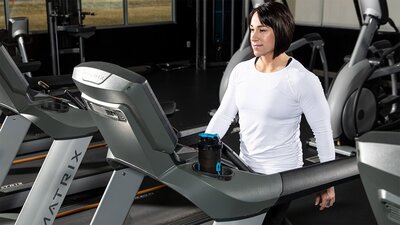If you've done any recent reading on cardio training, you've likely come to one solid conclusion: To shed pounds fast, high-intensity interval training (HIIT) is freaking awesome.
Fast-paced bursts of all-out cardio punctuated by short rest intervals have been touted as key for fat loss, and for good reason. HIIT burns more calories than low-intensity cardio per session. It also places greater recovery demands on your body, which causes you to burn more calories after training than you would in a standard hour-long treadmill session.
Plus, HIIT may actually increase testosterone levels. It can also boost GLUT4 concentration, which helps drive glucose into cells.
In addition, according to the American College of Sports Medicine, just two weeks of high-intensity intervals improves your aerobic capacity as much as 6-8 weeks of treadmill jogging. Pretty darn impressive, right?
So, knowing all this, you've probably set out on a mission to do nothing but strength training and HIIT workouts. After all, you're looking to keep fat levels at a minimum while building lean muscle. But is this really the route to go? Is high-intensity training always the best type of cardio for weight loss?
Take a moment to consider adding steady-state cardio to your training—slow and steady might not win the race, but it definitely has its place along the way. Here's what steady-state cardio will do for you.
1. You Will Recover Faster

Try low to moderately intense workouts to help increase blood flow to damaged muscle tissues and boost your recovery.
If you've allotted yourself an hour of daily gym time and consistently train hard, you might be forgetting one essential part of the equation: recovery. The effects of a workout don't stop once you leave the gym, and that feeling of fatigue might not either.
Sure, interval training allows you to complete a full cardio workout in less time, but it taxes your central nervous system to a high extent. If you couple HIIT with a number of other strength-training workouts throughout the week, you won't spur recovery; you might actually impede recovery.
If you're already using up most of your resources for strength training, you won't have much gas left in the tank to successfully complete multiple interval workouts. Chances are, you'll just be digging yourself deeper into the recovery hole—and making it harder to get out.
Moderation is the key. Coupling strength workouts with three days of high-intensity interval training every week could tap you out. In this case, the enhanced recovery you'd see with steady-state cardio training surpasses any potential fitness gains you'd get by doing more sprint work.
Try low- to moderate-intensity workouts to help increase blood flow to damaged muscle tissues and boost your recovery.
2. You Will Maintain Muscle Mass
Normally, sprint training—as opposed to moderately intense endurance work—is actually better for retaining lean muscle. Basically, it provides a stressor on the muscle that mimics weightlifting more than distance running does. However, there are exceptions. If you couple an intense low-calorie diet with numerous strength training and sprint workouts each week, you'll actually risk muscle mass loss.
Poor recovery and poor nutrition spell trouble. The harder you work out, the more glycogen you burn, which can leave you extremely hungry post-workout. Moderate intensity, steady-state cardio doesn't take as large a toll on your body as a HIIT session, which can make dieting easier and increase your calorie burn without over-stressing your system.
3. You Will Burn Calories
If you're someone who leads a relatively sedentary lifestyle—and typically goes from sitting at a desk to sitting on your couch—adding in some form of daily cardio is a wise move. But you might not be ready for HIIT. It's OK to scale things down. And yes, you'll still see results.

It's OK to scale things down. And yes, you'll still see results.
While you won't get the same post-workout calorie burn from moderate intensity, steady-state cardio as you would a good interval sprint session, you'll still burn a decent number of calories—and they do add up.
Thirty minutes of jogging can burn approximately 300 calories. Do that five days every week and you could lose almost two extra pounds per month.
4. You Will Build Up Your Aerobic Fitness
Steady-state cardio brings more benefits than weight loss. It's great for developing your aerobic fitness level and increasing your cardiovascular endurance.
The benefits of steady-state cardio are functional and translate to real life. If you participate in weekend adventure activities like hiking, cycling, or rowing, cardiovascular endurance is essential.
5. You Will Stick With It
Sometimes a fitness plan comes down to one simple question: Are you going to stick with it? While interval training might be the superior cardio modality for fat loss, if you absolutely hate sprint training, what good does it do you? Are you honestly going to keep up with your workouts if you dread doing them?

While interval training might be the superior cardio modality for fat loss, if you absolutely hate sprint training, what good does it do you?
First and foremost, remember the key role of enjoyment in exercise. The less you fear—or better yet, look forward to—your daily sweat session, the more likely you are to make it routine.
This isn't to say you should never do an exercise that doesn't top of your list of favorites, but if you despise every second of a training session and there are alternative options, consider switching things up.

